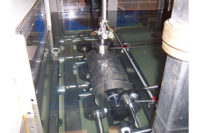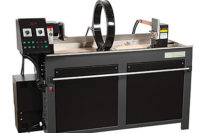
The instrument should be lightweight and easy to carry. Source: GE Measurement & Control Solutions
Selecting the right inspection equipment poses challenges for both service companies that need to maximize use of their ultrasound inspection units and asset owners across multiple industries that seek the right tool for all applications in their segments. How critical is portability? How many different types of devices will be needed? Which instruments have all the features and functionality required to perform the inspections and capture the data they require?
The good news is that advanced technologies now have enabled the combination of more than one application within the same instrument, a convenient option for both service companies and asset owners that need more than one inspection capability or have specific data reporting requirements. These versatile new instruments-with advanced capabilities for capturing and reporting data within a compact, handheld device-also are more cost-effective than in the past.
Inspection Needs Vary
What companies use nondestructive testing (NDT) equipment and what do they need? Service companies with NDT offerings are challenged with finding instruments that are portable and upgradable to accommodate additional inspection types. Their instruments must have size dimensions to allow for easy carrying, yet offer an optimized display size for readability.The devices also must hold up to rigorous use, as well as record and store large of amounts of data. Compatibility with data management systems and third-party software programs also is a requirement to allow for comprehensive analysis, documentation and reporting.
Finally, and perhaps most importantly, price is key to a service provider’s ability to purchase a larger volume of devices to accommodate business need.
Asset owners, such as refineries, power plants or airlines, have the same challenges with finding the right type of instruments with the right features-particularly multifunctional capability.

Flexibility is another reason to explore the possibilities of new, multiple-use inspection equipment options. Source: GE Measurement & Control Solutions
Evaluation Process
When evaluating options, be sure to look for the following features, which are now available with selected high-end products from major manufacturers:
The ideal instrument would include:
1. A large color screen for readability and a reduced number of controls for ease-of-use.
2. The ability to be used with one hand, with all functions in reach of the operator’s thumb.
3. Ambidextrous functionality, enabling the inspector to switch hands with one function key.
Other requirements include:
1. Large capacity to hold a wide range of data and provide the information in a variety of selectable industry standard formats such as JPEG (for images), CSV (for spreadsheets), PDF (for reports), and XML or DAT (to interface with other programs)
2. Large memory, providing the ability to upgrade from a 1 or 2 GB memory card to as large as 16 GB via SD card off the shelf at retail stores.
One thickness gage now available offers an on-board data recorder with a capacity of 100,000 readings in a single file with storage of A-scan, B-scan and microgrid attachments to thickness readings. The gage supports six different file formats to cover all possible inspection needs.
These instruments can easily be upgraded by means of a simple phone call to the supplier, eliminating the need to send them back to the manufacturer. Another benefit is reduced training time because the devices have the same interface and functions for all inspection applications.
Combining Functions Makes Sense
More than ever, companies across a wide range of industries-oil and gas, aerospace, power generation or automotive-seek more ways to keep costs down. Combining more than one function, such as a thickness gage with flaw detection capabilities, makes sense because operators are not required to sacrifice the features of one product in order to purchase another.With reasonable pricing made possible by advanced technology, operators now can have multiple applications, but with the same functionality and same data management features on one instrument. For example, a simple function enables the inspector to quickly switch from high performance thickness measurement to an ultrasonic flaw detector-a benefit for inspectors who use both functions but not necessarily at the same time.
Flexibility is another reason to explore the possibilities of new, -multiple-use inspection equipment options. Operators can economically start out with just one inspection capability and quickly upgrade to others at any time to accommodate new business or emergent work at a customer site.
Today’s industrial and regulatory environments mandate inspection data that is accurate and reliable. Advanced, flexible options are available, which allow service providers and companies in a wide range of industries to essentially design their instruments to suit their inspection needs-more cost-effectively than in the past.
Decision makers and buyers should carefully weigh these new, more versatile products against their business needs and be sure they offer the most up-to-date features required for efficient, safe and reliable inspections, along with robust data, selectable reporting and compatibility with other operator platforms.NDT


